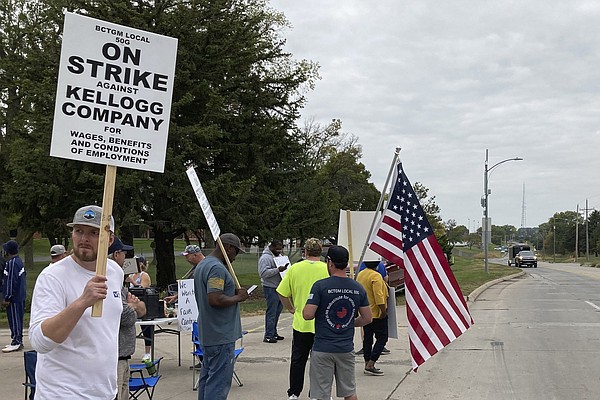[ad_1]
OMAHA, Neb. – A summer of social unrest among U.S. food manufacturers has dragged on into the fall, as workers tired by the pandemic continue to strike for better wages.
About 1,400 workers at Kellogg Co.’s US grain plants left work last week, saying negotiations with the company over wages and benefits have stalled. Meanwhile, in Kentucky, a strike of 420 workers against Heaven Hill Distillery is in its fifth week.
The actions come on top of strikes earlier this summer by 600 workers at one Frito-Lay plant in Topeka, Kansas, and 1,000 workers at five Nabisco plants in the United States. In June, Smithfield Foods narrowly avoided a strike by thousands of workers at a factory in Sioux Falls, SD
The number of shares is unusual. Kellogg says this is the first time its grain workers in the United States have gone on strike since 1972. Nabisco workers last quit their jobs in 1969.
But after a difficult 18 months, during which many workers worked 12-hour shifts and mandatory overtime to meet pandemic demand, employees are not in the mood to compromise.
“We’re drawing a line in the sand,†said Rob Long, a production mechanic who worked at the Kellogg plant in Omaha for 11 years.
Kellogg workers are also on strike in Michigan, Pennsylvania and Tennessee.
Long said he and others were unhappy with a two-tier employee system that offered fewer benefits and less pay to new workers, creating a rift in the ranks. Long said the company wanted to get rid of a provision that currently caps the lower level of workers at 30% of the workforce.
After decades of watching companies cut wages and benefits, food workers feel they have a rare advantage in the wake of the pandemic, said Patricia Campos-Medina, executive director of the Worker Institute of the ‘Cornell University, ILR School.
Labor shortages mean companies cannot easily find replacements for food production workers, she said. The pandemic has brought to light the essential – and sometimes dangerous – nature of their work.
“Workers in general demand that companies invest more in the workforce and not just use the profits for shareholders,” she said.
Campos-Medina said the trend is not just happening with unionized workers like those at Kellogg, who are members of the Bakeries, Confectionery, Tobacco and Millers Union.
Unorganized fast food workers have quit their jobs in dozens of American cities in search of a minimum wage of $ 15. Workers at three Starbucks stores in Buffalo, New York, are trying to organize.
The strikes come as food companies are still trying to get back to normal production levels.
Kellogg’s cereal sales had been sluggish for years, for example, as families turned to portable breakfast items like nutrition bars. But when schools closed and children returned home last year, grain sales in the United States soared 7%. So far this year they are down 7.7%.
Kris Bahner, Kellogg’s senior vice president for global corporate affairs, says the company’s compensation and benefits are already among the best in the industry.
The company, which is based in Battle Creek, Mich., Says its longer-term employees earned an average of $ 120,000 last year and $ 118,000 in 2019. Its proposed contract would move new workers to these. higher pay rates over six years, Bahner said.
“We are disappointed with the union’s decision to strike,” she said.
Kellogg began negotiating a new four-year contract on September 8. But workers on the picket line in Omaha say they regularly work 74 to 84 hours a week to make that money.
Some workers have said they’ve endured 12-hour shifts seven days a week throughout the pandemic, with just minutes’ notice of mandatory overtime.
“We’re making a lot of money, but we’ve given up a lot,†said Dan Jourdan, a packaging machine operator who has worked at Kellogg since 2001. “If we only worked 40 hours a week, we wouldn’t earn close to that. kind of salary. “
[ad_2]

